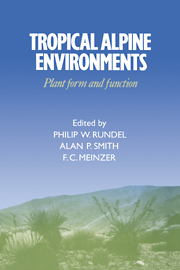Book contents
- Frontmatter
- Contents
- List of contributors
- Preface
- 1 Introduction to tropical alpine vegetation
- 2 Tropical alpine climates
- 3 Páramo microclimate and leaf thermal balance of Andean giant rosette plants
- 4 Comparative water relations of tropical alpine plants
- 5 Cold tolerance in tropical alpine plants
- 6 Anatomy of tropical alpine plants
- 7 Environmental biology of a tropical treeline species, Polylepis sericea
- 8 Morphological and physiological radiation in páramo Draba
- 9 Sediment-based carbon nutrition in tropical alpine Isoetes
- 10 Functional significance of inflorescence pubescence in tropical alpine species of Puya
- 11 Turnover and conservation of nutrients in the pachycaul Senecio keniodendron
- 12 Soil nutrient dynamics in East African alpine ecosystems
- 13 An overview of the reproductive biology of Espeletia (Asteraceae) in the Venezuelan Andes
- 14 Population biology of Mount Kenya lobelias
- 15 Population biology of Senecio keniodendron (Asteraceae), an Afroalpine giant rosette plant
- 16 Population dynamics and flowering in a Hawaiian alpine rosette plant, Argyroxiphium sandwicense
- 17 Plant form and function in alpine New Guinea
- 18 Alpine herbivory on Mount Kenya
- 19 Biotic interactions in Hawaiian high elevation ecosystems
- 20 Tropical alpine ecology: progress and priorities
- Index
Preface
Published online by Cambridge University Press: 21 October 2009
- Frontmatter
- Contents
- List of contributors
- Preface
- 1 Introduction to tropical alpine vegetation
- 2 Tropical alpine climates
- 3 Páramo microclimate and leaf thermal balance of Andean giant rosette plants
- 4 Comparative water relations of tropical alpine plants
- 5 Cold tolerance in tropical alpine plants
- 6 Anatomy of tropical alpine plants
- 7 Environmental biology of a tropical treeline species, Polylepis sericea
- 8 Morphological and physiological radiation in páramo Draba
- 9 Sediment-based carbon nutrition in tropical alpine Isoetes
- 10 Functional significance of inflorescence pubescence in tropical alpine species of Puya
- 11 Turnover and conservation of nutrients in the pachycaul Senecio keniodendron
- 12 Soil nutrient dynamics in East African alpine ecosystems
- 13 An overview of the reproductive biology of Espeletia (Asteraceae) in the Venezuelan Andes
- 14 Population biology of Mount Kenya lobelias
- 15 Population biology of Senecio keniodendron (Asteraceae), an Afroalpine giant rosette plant
- 16 Population dynamics and flowering in a Hawaiian alpine rosette plant, Argyroxiphium sandwicense
- 17 Plant form and function in alpine New Guinea
- 18 Alpine herbivory on Mount Kenya
- 19 Biotic interactions in Hawaiian high elevation ecosystems
- 20 Tropical alpine ecology: progress and priorities
- Index
Summary
With current attention on global problems of biodiversity and climate change, environmental interest in tropical ecosystems has increased tremendously. Very often, nevertheless, tropical biology is focused on lowland humid forests. High mountain systems, however, are also an important feature of tropical landscapes. Compared to lowland tropical forests, there has been surprisingly limited interest in the ecology of organisms in these tropical systems.
Scientific interest in the flora of tropical alpine regions goes back to the middle of the eighteenth century when Joseph de Jussieu and Charles La Condamine collected plants and mapped the high mountain areas of Ecuador as part of a five-year expedition of the French Académie des Sciences. The most vivid early scientific accounts of tropical alpine environments, nevertheless, came from travels of Alexander von Humboldt in South America and Mexico at the beginning of the nineteenth century. Accompanied by a capable young botanist named Aimé Bonpland, Humboldt travelled extensively through the high páramos of Colombia, Ecuador, and northern Peru. The patterns of vegetation zonation which he observed on this trip had a great impact on his thinking, and helped lead to the founding of the modern science of biogeography. The roots of modern ecology can also be traced to this experience which demonstrated to Humboldt the importance of interrelationships between climate, soils and biotic communities. Humboldt saw clearly that the peculiar vegetation of the páramos of the northern Andes was unlike any alpine community in temperate mountain ranges.
- Type
- Chapter
- Information
- Tropical Alpine EnvironmentsPlant Form and Function, pp. xiii - xivPublisher: Cambridge University PressPrint publication year: 1994



